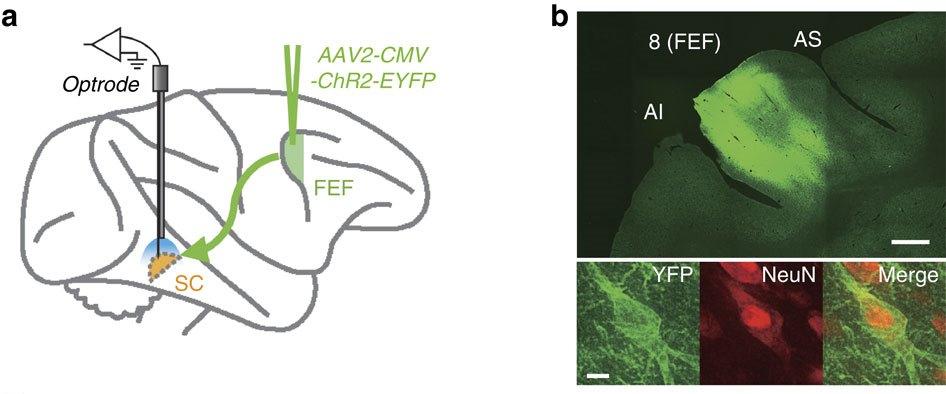Research News
Lighting tool to regulate cerebral neural circuit in the primates
Brains of human and monkeys consist of more than one hundred billion neurons as a complex neural circuit for high-level brain functions. In order to understand the mechanism of the high-level brain functions and details of mental and neural symptoms, a technology is requited to regulate the function of a certain neural circuit in a complicated brain network.
A research team of Masayuki Matsumoto of Medical School at the University of Tsukuba by the collaboration with the Primate Research Institute at Kyoto University succeeded for the first time in developing the light-irradiating technology to activate selectively a targeted neural circuit in primates. The team focused on the neural network to control eye movements. Among neural networks to regulate the eye movements in the brain, the team looked at the neural circuit from frontal eye field in the frontal lobe of the cerebrum to superior colliculus in the midbrain. And then, they used virus vector to make a certain protein expressed in order to activate the neural reaction by light-irradiation.
In this way, the light-irradiation to the frontal eye field and superior colliculus can control the neural activities of superior colliculus with precise timing, at the same time, the research team succeeded in artificial make the eye movements of monkey by the activation of the related neural circuit in brain.
The technology developed this time would be able to regulate the only targeted neural circuit in primates at an appropriate timing. The research accomplishment is expected to apply to the research of human high-level brain functions and new perspectives in mental/neural disorders along with better cure.

Experimental design and histological analysis.
(a) Schema of experimental configuration. (b) ChR2-EYFP expression in the FEF. Top, wide-field fluorescent image of a coronal section through the FEF. Bottom, immunofluorescence of an FEF neuron example (left, YFP; middle, NeuN; right, YFP and NeuN). Scale bars, 2mm for the top panel and 10µm for the bottom panels. AI, inferior limb of the arcuate sulcus; AS, superior limb of the arcuate sulcus.
Original Paper
Ken-ichi Inoue, Masahiko Takada and Masayuki Matsumoto, Nature Communications, Neuronal and behavioural modulations by pathway-selective optogenetic stimulation of the primate oculomotor system. DOI: 10.1038/ncomms9378


